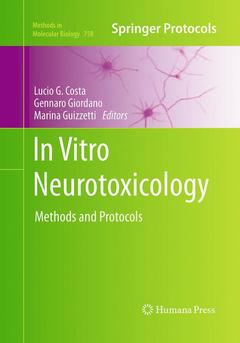Description
In Vitro Neurotoxicology, Softcover reprint of the original 1st ed. 2011
Methods and Protocols
Methods in Molecular Biology Series, Vol. 758
Language: English
Subjects for In Vitro Neurotoxicology:
Support: Print on demand
415 p. · 17.8x25.4 cm · Hardback
Description
/li>Contents
/li>Comment
/li>
In recent years, the need to develop acceptable alternatives to conventional animal testing for neurotoxicity and developmental neurotoxicity has been increasingly recognized, and much effort is being directed toward the development of alternative models, utilizing mostly mammalian cells in culture but also non-mammalian model systems. In Vitro Neurotoxicology: Methods and Protocols presents a series of cellular, biochemical, and molecular methodological protocols in the area of in vitro neurotoxicology, with an emphasis on mammalian cell culture systems. Opening with a section on methodologies for preparing several cellular systems of variable complexity, amenable for in vitro neurotoxicological studies, the thorough volume continues with coverage of methods to measure cellular death and major mechanisms, methods for assessing mechanisms of nervous system cell toxicity related to impairment of cell signaling, while a final section illustrates additional methods for assessing important nervous system processes such as cell proliferation, neuritogenesis, and synaptogenesis. Written in the highly successful Methods in Molecular Biology? series format, chapters include introductions to their respective subjects, lists of the necessary materials and reagents, step-by-step, readily reproducible laboratory protocols, and tips on troubleshooting and avoiding known pitfalls.
Comprehensive and cutting-edge, In Vitro Neurotoxicology: Methods and Protocols serves researchers with an interest in assessing or characterizing the potential neurotoxicity of environmental contaminants, drugs, or other chemicals.
In Vitro Neurotoxicology: An Introduction.- Primary Neurons in Culture and Neuronal Cell Lines for In Vitro Neurotoxicological Studies.- Determination of Metal Interactions with the Chaperone Hspa5 in Human Astrocytoma Cells and Rat Astrocyte Primary Cultures.- Microglia Cell Culture: A Primer for the Novice.- Neural Stem Cells for Developmental Neurotoxicity Studies.- Preparation, Maintenance, and Use of Serum-Free Aggregating Brain Cell Cultures.- Neurospheres as a Model for Developmental Neurotoxicity Testing.- Acute Hippocampal Slice Preparation and Hippocampal Slice Cultures.- Glia-Neuron Sandwich Co-Cultures: An In Vitro Approach to Evaluate Cell-to-Cell Communication in Neuroinflammation and Neurotoxicity.- In Vitro Models to Study the Blood Brain Barrier.- Measurements of Cell Death in Neuronal and Glial Cells.- Measurements of Neuronal Apoptosis.- Measurement of Isoprostanes as Markers of Oxidative Stress.- Assessment of Glutathione Homeostasis.- Assessing Neuronal Bioenergetic Status.- Fluorescent Assessment of Intracellular Calcium in Individual Cells.- Homeostatic Regulation of Glutamate Neurotransmission in Primary Neuronal Cultures.- Detection of Nitric Oxide Formation in Primary Neural Cells and Tissues.- JNK3-Mediated Apoptotic Cell Death in Primary Dopaminergic Neurons.- Measurement of Proteasomal Dysfunction in Cell Models of Dopaminergic Degeneration.- Cell Signaling and Neurotoxicity: Protein Kinase C In Vitro and In Vivo.- Cell Signaling and Neurotoxicity: 3H-Arachidonic Acid Release (Phospholipase A2) in Cerebellar Granule Neurons.- Quantitative Assessment of Neurite Outgrowth in PC12 Cells.- Measurements of Astrocyte Proliferation.- Quantification of Synaptic Structure Formation in Co-Cultures ofAstrocytes and Hippocampal Neurons.- Volume Measurements in Cultured Primary Astrocytes.- Assessment of Cholesterol Homeostasis in Astrocytes and Neurons.- Dose-Response or Dose-Effect Curves in In Vitro Experiments and Their Use to Study Combined Effects of Neurotoxicants.
These books may interest you

Neurotoxicology 71.13 €

Experimental Neurotoxicology Methods 263.74 €

AstrocytesMethods and Protocols 174.06 €

